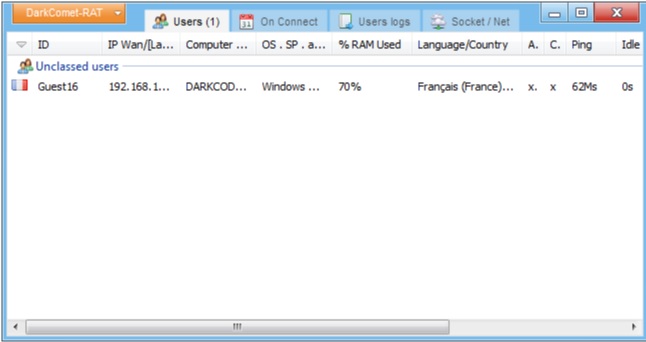Understanding RATs
In the dynamic landscape of cybersecurity, the Remote Access Trojan (RAT) emerges as an enduring and sophisticated menace. Functioning as a specialized form of malware, RATs excel in providing unauthorized remote access to a victim’s computer system. However, their objective surpasses mere infiltration; instead, they prioritize establishing covert control to facilitate a spectrum of malicious activities. At the core of RAT functionality is clandestine control over compromised systems. Unlike other malware forms that seek rapid exploitation, RATs prioritize sustained access, allowing cybercriminals to operate discreetly over prolonged periods. This protracted presence enables advanced surveillance capabilities, empowering attackers to monitor user activities remotely, employ keylogging for data capture, and access files and data surreptitiously.
 The versatility of RATs extends beyond surveillance to encompass a diverse range of malicious activities. Attackers can leverage RATs to deploy ransomware, gain unauthorized access to financial records, manipulate critical system files, or exfiltrate classified information. The flexibility of RATs positions them as favored tools for cybercriminals with diverse objectives. RATs are engineered to evade traditional security measures, employing sophisticated techniques such as polymorphic coding and encryption to circumvent antivirus software and intrusion detection systems. This adaptability enhances their longevity and effectiveness in compromising systems without triggering alarms.
The versatility of RATs extends beyond surveillance to encompass a diverse range of malicious activities. Attackers can leverage RATs to deploy ransomware, gain unauthorized access to financial records, manipulate critical system files, or exfiltrate classified information. The flexibility of RATs positions them as favored tools for cybercriminals with diverse objectives. RATs are engineered to evade traditional security measures, employing sophisticated techniques such as polymorphic coding and encryption to circumvent antivirus software and intrusion detection systems. This adaptability enhances their longevity and effectiveness in compromising systems without triggering alarms.
The persistence of RATs as a prevalent threat underscores the ongoing challenges faced by cybersecurity professionals. Their dynamic nature, coupled with the continually evolving tactics employed by attackers, necessitates a proactive and adaptive cybersecurity approach. Organizations and individuals must prioritize the implementation of cutting-edge security protocols, regular system audits, and employee training programs to effectively mitigate the risks posed by Remote Access Trojans.
Key Characteristics of Remote Access Trojans
- Stealth and Persistence: RATs are designed to operate stealthily, often evading traditional antivirus and intrusion detection systems. They embed themselves within legitimate programs or files, making detection challenging. Once infiltrated, they establish persistence by modifying system settings or creating backdoors, ensuring continued access for the attacker.
- Remote Control: The defining feature of RATs is their capacity to enable remote control of the infected system. Attackers can manipulate files, execute commands, capture keystrokes, and even activate peripheral devices such as cameras or microphones without the user’s knowledge.
- Data Theft and Espionage: RATs serve as powerful tools for cyber espionage and data theft. Attackers can exfiltrate sensitive information, such as login credentials, personal data, intellectual property, or financial records. This stolen data can be exploited for various malicious purposes, including identity theft or unauthorized access to corporate networks.
- Propagation and Exploitation: RATs often exploit vulnerabilities in software or rely on social engineering tactics to propagate. Phishing emails, malicious downloads, or compromised websites serve as common vectors for RAT infections. Once a RAT gains access to a system, it can be used to spread to other connected devices within a network.
Examples of Notorious RATs:
- DarkComet: DarkComet is a RAT known for its robust remote control capabilities. It allows attackers to perform tasks such as taking screenshots, recording webcam feeds, and downloading/uploading files discreetly.
- Poison Ivy: Poison Ivy is a sophisticated RAT that has been utilized in numerous targeted attacks. It provides a comprehensive suite of espionage tools, including keylogging, screen capture, and file manipulation.
Why RATs Are Popular in Hacking:
Remote Access Trojans (RATs) have gained widespread popularity among hackers due to their adaptability and versatility. Unlike more specialized malware, RATs offer a modular framework, making them suitable for a variety of cyber attacks by allowing customization based on specific objectives. A key draw of RATs is their ability to establish and maintain long-term access to compromised systems, making them invaluable for cybercriminals engaged in activities like espionage, data theft, or ongoing network exploitation. This sustained access provides a reliable foundation for carrying out malicious operations over extended periods.
RATs play a significant role in cyber espionage and data exfiltration, enabling remote monitoring of user activities and discreet access to sensitive information. This stolen data, ranging from login credentials to financial records, provides hackers with valuable assets for exploitation. Beyond their initial compromise, RATs facilitate further network exploitation by propagating within networks, compromising additional systems, and allowing lateral movement. This capability is attractive to attackers seeking to expand their reach within a targeted infrastructure.
Moreover, RATs operate covertly, evading traditional security measures through tactics like polymorphic coding and encryption. Their ability to operate discreetly contributes to persistently low detection rates, allowing for prolonged compromise without triggering alarms.
In essence, the appeal of RATs in hacking lies in their adaptability, providing cybercriminals with versatile tools for various malicious objectives. With features like long-term access, espionage capabilities, and potential for further network exploitation, RATs remain formidable instruments in exploiting digital system vulnerabilities for personal gain.
Technical Insights: How RATs Evade Detection in Windows Environments
Remote Access Trojans (RATs) are notorious for their ability to slip past traditional security measures within Windows environments. Here, we’ll dive deeper into the technical aspects of how RATs effectively evade detection:
Polymorphic Code Generation
RATs often employ polymorphic code, which continuously mutates their code signatures. This technique makes it challenging for signature-based antivirus software to identify and block them. Each RAT instance appears unique, rendering static signature-based detection ineffective. Polymorphism allows RATs to adapt quickly to new environments and evade signature-based scans.
Dynamic Linking and Code Injection
RATs use dynamic linking to import external libraries and code components at runtime, rather than being statically linked. This dynamic nature obscures their presence in memory.
They may also use code injection techniques to insert malicious code into legitimate processes, hiding within the memory space of trusted applications. This camouflage makes them harder to detect through standard memory analysis.
Rootkit Capabilities
Some advanced RATs possess rootkit capabilities, allowing them to operate at the kernel level of the Windows operating system. This grants them high-level privileges and the ability to manipulate system functions while evading detection.
Rootkits can tamper with system calls and memory structures, making it challenging for security tools to detect their activities.
Encrypted Communication
To communicate with Command and Control (C&C) servers, RATs often employ strong encryption protocols. This encryption ensures that network traffic appears as normal HTTPS or other encrypted traffic, making it difficult to identify malicious communication patterns.
Traditional traffic analysis may not flag RAT-related traffic as suspicious, further allowing them to evade detection.
Process Hollowing and Injection
RATs may use process hollowing, a technique where they create a legitimate process and then replace its code with their malicious code. This disguises their presence as a legitimate process.
Process injection involves inserting RAT code into the address space of another process, avoiding detection by running independently within a trusted process.
Anti-Sandbox and Anti-Debugging Techniques
RATs often incorporate anti-sandbox and anti-debugging measures, designed to detect whether they are running in a controlled environment or under observation.
When RATs detect a sandbox or debugger, they may remain dormant or alter their behavior to avoid revealing their malicious nature.
Fileless Execution
Some RATs execute in a fileless manner, residing solely in memory without leaving a trace on the disk. This technique bypasses file-based antivirus scans. Since no files are written to the disk, traditional endpoint security solutions may struggle to detect or analyze their presence.
Understanding these technical evasion tactics is crucial for cybersecurity professionals tasked with defending Windows environments. Detecting and mitigating RATs require a combination of advanced threat detection tools, behavioral analysis, network monitoring, and regular security updates to minimize vulnerabilities that RATs might exploit. Staying one step ahead of these stealthy threats is essential in today’s cybersecurity landscape.
Conclusion
The prevalence of Remote Access Trojans (RATs) in cybersecurity necessitates a proactive defense strategy. Employing a diverse security approach, including firewalls and advanced antivirus tools, is crucial to fortify against the adaptable tactics of RATs.Integrating advanced threat detection systems and leveraging AI and machine learning enhances the ability to swiftly identify and respond to RAT activities, preventing potential breaches. Employee training on RAT tactics, such as phishing, plays a vital role in empowering personnel to recognize and report threats. Regular system updates and patch management are essential to reduce vulnerabilities. Continuous monitoring and robust incident response plans enable quick detection and containment of potential RAT intrusions. Collaboration and information sharing among organizations amplify the collective defense against emerging RAT threats. In essence, countering RATs demands a comprehensive, adaptive cybersecurity approach that combines advanced detection, training, regular updates, vigilant monitoring, and collaborative efforts to safeguard digital landscapes.





